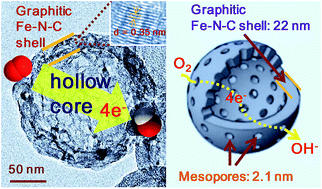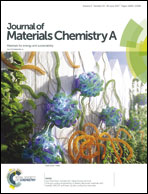Achieving excellent activity and stability for oxygen reduction electrocatalysis by hollow mesoporous iron–nitrogen-doped graphitic carbon spheres†
Abstract
The replacement of platinum (Pt) by nonprecious catalysts with superior activity and stability for the oxygen reduction reaction (ORR) remains challenging for fuel cell devices. Herein, we describe a controllable strategy to prepare hollow graphitic carbon spheres with Fe–N-doped mesoporous shells via in situ polymerization and functionalization. The optimized catalyst exhibits very superior ORR activity with a half-wave potential (E1/2) of 0.886 V in 0.1 M KOH, 15 mV more positive than that of commercial Pt/C catalysts. Even in acidic solution, it also shows a competitive 4e− ORR activity compared to Pt/C. Most importantly, it demonstrates much better long-term stability and resistance to methanol crossover than Pt/C in both alkaline and acidic media. The outstanding activity is contributed by the synergy of chemical functions (Fe–Nx-coordinated moieties) and excellent structural properties (hollow large cores (∼91 nm), open mesopores (∼2.1 nm) throughout the shells, and highly graphitic microstructures), ensuring rapid mass-diffusion and electron-transfer kinetics and full accessibility of catalytic sites.



 Please wait while we load your content...
Please wait while we load your content...